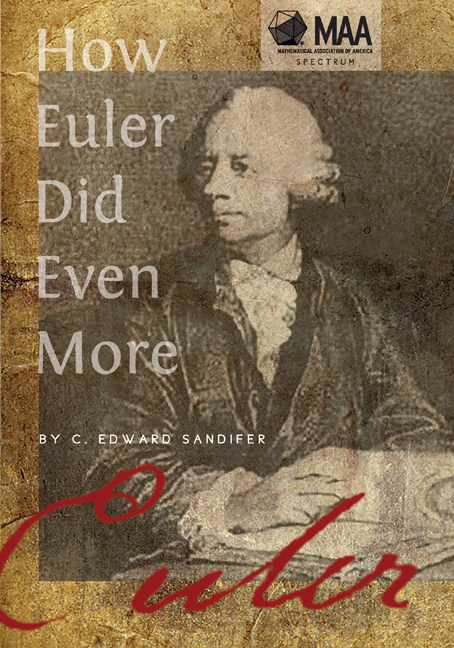Book contents
- Frontmatter
- Contents
- Preface
- Part I Geometry
- Part II Number Theory
- Part III Combinatorics
- Part IV Analysis
- Part V Applied Mathematics
- 26 Density of Air (July 2009)
- 27 Bending Light (August 2009)
- 28 Saws and Modeling (November 2008)
- 29 PDEs of Fluids (September 2008)
- 30 Euler and Gravity (December 2009—A Guest Column by Dominic Klyve)
- Part VI Euleriana
- About the Author
30 - Euler and Gravity (December 2009—A Guest Column by Dominic Klyve)
from Part V - Applied Mathematics
- Frontmatter
- Contents
- Preface
- Part I Geometry
- Part II Number Theory
- Part III Combinatorics
- Part IV Analysis
- Part V Applied Mathematics
- 26 Density of Air (July 2009)
- 27 Bending Light (August 2009)
- 28 Saws and Modeling (November 2008)
- 29 PDEs of Fluids (September 2008)
- 30 Euler and Gravity (December 2009—A Guest Column by Dominic Klyve)
- Part VI Euleriana
- About the Author
Summary
The popular myth of the discovery of gravity goes something like this: one day, an apple fell on the head of a young Isaac Newton. After pondering this event, Newton wrote down an equation describing an invisible force, which he called gravity. This equation united ideas about the paths of cannon balls and apples (terrestrial motion) with the paths of moons and planets (celestial motion). Once it was written down, it elegantly and easily explained the motion of all the planets and moons, and remained unquestioned, revered, and perfect for centuries (at least until Einstein).
Readers who are familiar with the history of science know better; nothing is ever so simple. In fact, Newton's theory was accepted, tested, clung to, retested, questioned, revised and un-revised, and finally accepted again during the 75 years after the publication of Newton's Principia. More importantly for our purposes, Euler was at the center of all of it.
Prelude to a crisis
De Causa Gravitatis
Euler had been thinking about gravity even before the worst of the chaos mentioned above. In 1743, he published an anonymous essay, De Causa Gravitatis [Euler 1743]. The essay itself is remarkable for two reasons: first, it was published anonymously. This seems to have been a technique that Euler used to get ideas out to the public without having to publicly defend them, which gave him greater leeway to experiment with bold claims. Furthermore, it was published only two years after he arrived at his new job in Berlin, and written even closer to the time of his move, and we might guess that Euler was especially keen not to publish anything controversial before he had settled in. The second remarkable thing about this paper is that it does not have an Eneström number. The man who cataloged all of Euler's works early in the 20th century missed this one completely. We only know today that Euler is the author because Euler admitted it in a letter written 22 years later to Georges-Louis Lesage (see [Kleinert 1996] for an interesting introduction to de Causa and its discovery).
- Type
- Chapter
- Information
- How Euler Did Even More , pp. 199 - 206Publisher: Mathematical Association of AmericaPrint publication year: 2014



